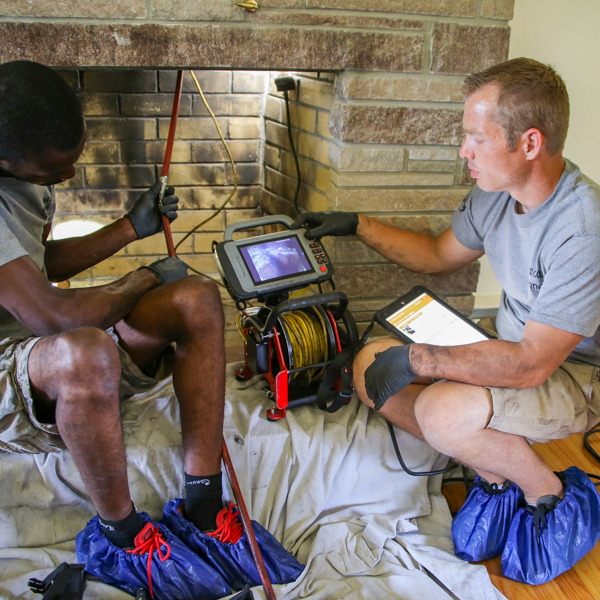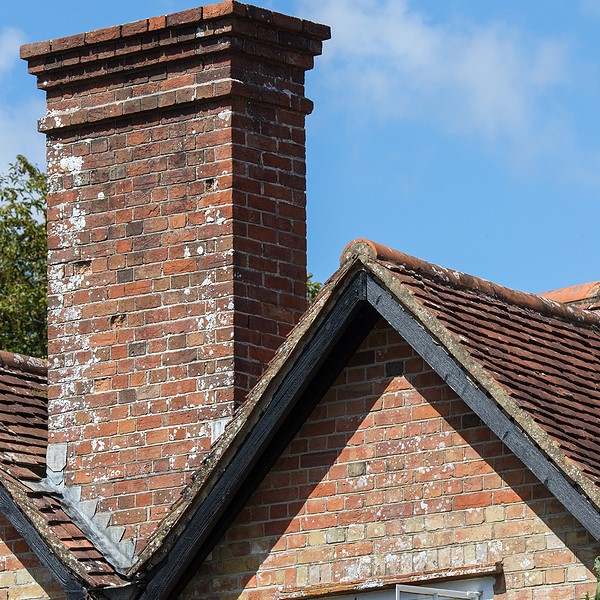Why is My Chimney Discolored?
Have you noticed that your chimney looks drab or discolored? This might seem like a mild aesthetic issue, but as we’ll show you, it could be a sign of an underlying problem that could put your chimney at risk of water damage and deterioration.
 What Causes Chimney Discoloration?
What Causes Chimney Discoloration?
Understanding Discoloration in Chimneys:
Causes and Solutions
Creosote Buildup
One of the most common causes of chimney discoloration is creosote, a dark, tar-like substance that’s a byproduct of burning wood. Over time, creosote sticks to the interior chimney walls, causing a dark brown or black discoloration. Creosote not only looks bad, but it’s also extremely flammable. The Chimney Safety Institute of America recommends annual chimney cleaning and inspections by trained professionals to remove creosote for your safety.
Weather & Environment
Chimneys suffer effects from rain, wind, snow, and sunlight, which can cause discoloration. Rainwater, for instance, can mix with the soot and creosote in the chimney, causing stains. Exposure to the sun’s ultraviolet (UV) rays can cause fading and discoloration. Applying waterproof sealants and UV protectant coatings can help mitigate the weathering effects, keep your chimney looking clean, and protect it from water damage.
Efflorescence
Efflorescence is a white, powdery substance on masonry surfaces like bricks and mortar. It occurs when water seeps into the bricks and evaporates, leaving salt behind, creating white deposits. While efflorescence itself is not harmful, it can indicate moisture issues within the chimney, such as leaks or poor ventilation. Water is the number one enemy of your chimney and can lead to deteriorating mortar joints and bricks.
Rust & Corrosion
If you notice reddish-brown stains or discoloration on your chimney, it may be a sign of rust and corrosion. Metal components of the chimney, such as the chimney cap, flashing, or damper, are susceptible to rust when exposed to moisture. Poorly installed or damaged chimney caps can allow water to seep in, accelerating the rusting process. This is why it’s essential to hire a professional for yearly inspection and maintenance to deal with rust before it gets out of hand.
Soot & Smoke Residue
While it may seem obvious, soot and smoke residue are the primary culprits for chimney discoloration. When a fire burns, it releases smoke and soot particles that can stick to the chimney walls. Over time, these particles can accumulate and create a dark, smoky appearance. Routine chimney cleanings, both from the inside and outside, can remove the built-up soot and restore the chimney’s original appearance. A discolored chimney not only detracts from the overall aesthetic of your home but can also indicate potential issues, like water damage and creosote buildup, that require attention from a trained professional.
As mentioned, hiring certified professionals to clean, inspect, and maintain your chimney is essential. Certified pros have the training, tools, and knowledge to detect and repair issues before they develop into situations that could lead to a fire or chimney collapse.

Regular chimney inspections, cleanings, and maintenance are essential to prevent discoloration caused by creosote buildup, weathering, efflorescence, rust, and soot.
By addressing these issues promptly, you can maintain the visual appeal of your chimney while ensuring its safety and longevity.
Call Mercer County Chimney Services
If your chimney looks old and tired, call us to restore it to its former glory. We’re a family-owned chimney and fireplace company, proudly serving residents throughout Hamilton, NJ, and Mercer County.
Our technicians are certified by the Chimney Safety Institute of America and the National Fireplace Institute, so you can trust our work is safe and accurate.
Book your appointment today by calling 609–802–5288 or filling out our online form.


